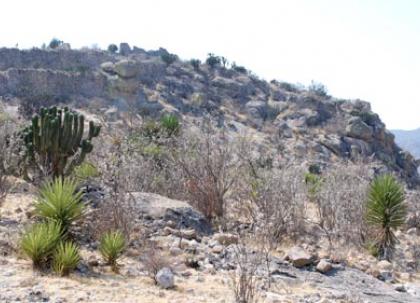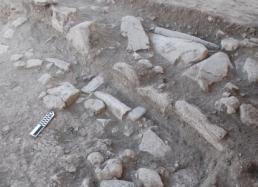5: Houses: Ancient and Modern
One of the key factors that drew our Field Museum team to excavations at the Mitla Fortress this year was the possibility of finding a sequence of occupation that bracketed the so-called Classic-Postclassic transition in the Valley of Oaxaca. In speaking of this era of transition in Prehispanic Mesoamerica, I run the risk of approaching “inside baseball” or archaeological jargon/minutiae. But, since it's central to our being here, let’s give it a try.
In Mesoamerica, the Classic period (ca. A.D. 200-900) was the era when the early great cities, such as Teotihuacan in central Mexico, Maya Tikal and Calakmul, and Monte Albán in the Valley of Oaxaca, rose to prominence and held sway over their surrounding regions. By the 7th through 9th centuries, many of these early centers had reached their apex and others were in the process of decline, so that the time from A.D. 900-1200 was an era of marked change, population redistribution, and political reorganization with some regions gaining importance and others in decline.
After A.D. 1200, by the later Postclassic period, ancient Mesoamerica experienced another episode of growth, characterized by increased volumes of long-distance exchange and the eventual rise of the Aztec empire. Specifically in the Valley of Oaxaca, the Classic period was dominated by the Zapotec capital of Monte Albán.
Monte Albán’s decline coincided with the end of the Classic period, and a number of other Late-Classic-period Valley of Oaxaca centers, such as El Palmillo, were in eclipse by the 9th century A.D. By the 1200s through the early 1500s, the Valley was organized differently, no longer so focused on one dominating center for centuries, and characterized by new styles of pottery and novel architectural conventions.
In the first half of the 20th century, some scholars saw these shifts as so extensive that they envisioned a population or ethnic replacement, viewing the Postclassic Valley of Oaxaca as having been dominated by Mixtecs rather than the Zapotecs as at earlier Monte Albán. Frankly, although recognizing that the Classic-Postclassic transition did engender significant change, I've always been rather skeptical of that perspective, since both in the 16th century (right after Spanish conquest), as well as today, most speakers of indigenous languages in the Valley of Oaxaca speak Zapotec, not Mixtec.
Not withstanding these ongoing debates, we, as researchers, have more questions than answers when it comes to the decline of Monte Albán and Valley populations (ca. A.D. 800-900), the organization of the Valley immediately following this decline, or what prompted the region’s demographic revival and restructuring after A.D. 1200.
When we began our plans for the Fortress, we hoped that we might gain new insights regarding these questions and the Classic-Postclassic Transition through research there. When we surveyed the site intensively in 1998, we found large quantities of both Classic and Postclassic pottery on the surface. We also knew that just about all of the radiocarbon dates that are assigned to the period between A.D. 900-1200 for the entire Valley of Oaxaca come from the Mitla area (see above photo.)
It's still extremely early in the research process, so everything is subject to re-evaluation, but we may be getting some of what we were searching for through excavations of a terrace at the Fortress. So far, we appear to have a sequence of uses of this terrace that begin in the Late Classic and extend into the Late Postclassic.
The last (Late Postclassic) use of this particular terrace was as a defensive lookout and a place where burials were interred. But that last use was preceded by two occupational surfaces when the terrace was the setting for a multi-room residence (see Photo #1 below.) I say this with the caveat that we haven't yet excavated down to bedrock, so we still may find something earlier.
We also can't be sure whether there was a gap in this sequence of use, although presently we have no clear evidence of such a hiatus. Significantly, the span of these two residential uses seems to cross the Classic-Postclassic eras, although the plans for the two residential complexes show a fair degree of continuity (eventhough wall orientations are slightly offset). Perhaps significantly, the earlier residential surface was entirely burnt at abandonment. Clearly, until much more ceramic study has been implemented and a suite of carbon dates run, all these observations remain rather speculative.
As we've puzzled to tease out the architectural plans of two superimposed residential surfaces on Terrace 56 at the Fortress (one destroyed by fire and the later practically on the modern ground surface), it's hard not to think back to (pine for) the wonderful architecture with intact adobe walls and lime plaster floors in exquisite condition that we were exposing last year at this time at El Palmillo.
Why were they in so much better condition? For one, during the last years at El Palmillo, we excavated palaces with thick, well-constructed walls and floors. These elaborate residences were rebuilt often. In contrast, this year at the Fortress, we're studying people of lesser means, who lived in less ample structures that likely were more rarely rebuilt. In addition, there was/is more sediment available at El Palmillo than at the Mitla Fortress. So the separating fill levels were thicker/deeper between superimposed occupations. These deeper fill layers were beneficial for archaeological preservation.
While houses of the past consume the lion’s share of our mental energies, it's impossible to avoid also thinking occasionally about our residential life here in contemporary Mitla, because it's different from what most of us are used to in the United States today. In Mitla, water is in short supply right now. It hasn't rained for some time, and reflecting global patterns, the water table is down a good deal from decades ago. Mitla is situated in the driest arm of the Valley of Oaxaca, and for the most part, this is good for archaeology, especially when excavating on the side of a hill. But, it can present some impediments when it comes to getting a hot shower.
When we rent houses, water is generally procured in one of two ways. Either it's gotten through deliveries from the municipal government or it is purchased from people whose business it is to deliver water in large tanks. In the most ample houses today, water is stored in large underground cisterns. As needed, it's then generally pumped on to the roofs of those houses where it's stored in thick rubber tanks that feed the faucets, showers, and toilets in the residence below. To get hot water, you need to buy tanks of propane that are used to run the water heaters that provide hot water.
Although we live in rather ample, even luxurious, houses by Mitla standards, here is one sequence of domestic events that affected two good-natured novice Oaxacanists, Tasha and Lacey, in search of a shower this week. First, the propane tank ran out of gas, robbing the water heater of its required fuel. Although buying a new tank was easy, it took a concerted effort to re-attach the tank to the heater, due to stripped threads on the connecting pieces.
Once this was accomplished, the warm sunny weather hid the fact that the pilot light on the water tank was never re-lit, rendering truly hot water unattainable. By the time that a Norte (northerly front) rolled in with cool and cloudy weather for a few days, the issue of the unlit pilot was noted. But by then, another problem emerged, the cistern was running out of water.
Several days of calls later, both Mitla’s water delivery system and a responsive water seller rose to the call, providing water for the cistern. A hot shower seemed in sight. But, unfortunately, just as we endeavored to move water from the cistern to the water tank above, it was discovered that the pump necessary for this job was on the fritz, and the dream of a truly hot shower remained just that. Ojalá mañana!
Word of the Day: Ojalá, which means “if only it was so” or “let’s hope so.” This word entered the Spanish language from Arabic (as a call to Allah) during the North African expansion into Spain, which took place not too long before the early 16th century Spanish intrusion into Mexico.
More soon,
Gary






